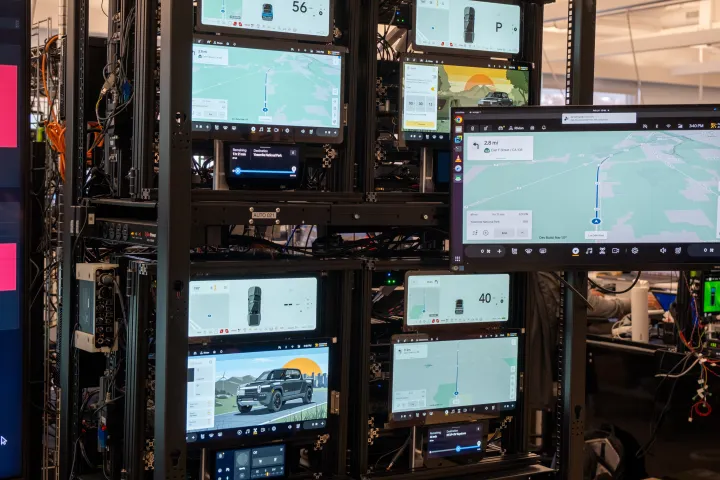The car world is kind of split right now. There are the legacy automakers — the ones you know and love — but there are also the new startups building all-new kinds of cars. The first of that new generation of car companies was Tesla, and obviously by now it’s certainly not a startup. But over the past decade or so others have popped up. There’s Lucid , which builds ultra-premium EVs, and, of course, there’s Rivian, which has secured its spot as the go-to for those who want a more rugged EV.
I was recently able to tour Rivian’s Palo Alto location and one thing became clear. The divide between traditional carmakers and the new startups is much deeper than just when they were founded. Companies like Rivian, in fact, are actually tech companies, that built high-quality computers that happen to have wheels on them.
It sounds like a put-down, but it’s not. For all the problems with computers, and all the risks of bringing those problems into such a critical environment, computers are clearly the future of personal transportation — and until legacy automakers stop thinking about their cars as cars, and more as computers, they’re doomed to lag behind the new kids on the block.
Computers…but not too many computers
Rivian’s first-generation vehicles were hailed for their quality and performance, but earlier this year, the company shifted to its second-generation architecture . The core of that change? More features and smarter software. You’d think this would require more computers under the hood, but on the contrary, Rivian managed to shrink the number down, by a significant margin. While its first-generation platform was made up of 17 Electronic Control Units (ECUs), second-gen models only have seven.

The key to that change comes down to a switch to a zonal architecture, instead of a domain-based architecture. The general gist is that instead of different functions in the car being handled by different ECUs, different areas of the car are handled by different ECUs. Three of the seven ECUs in current Rivian vehicles are zone-based, called the west zone, east zone, and south zone. These ECUs handle all the basic tasks of the vehicle, with the other four handling more mission-critical tasks, like infotainment and autonomy.
This results in some pretty major improvements. For starters, a zonal architecture means wires don’t necessarily have to be run back and forth between all the different ECUs, and Rivian says that it was able to shrink down the wiring in its second-gen vehicles by a massive 1.6 miles, and 44 pounds. The different is obvious in person — simply far less wires spider-webbing their way around the frame of the car. And, fewer wires and computers means fewer points of failure, which is always helpful.

Of course, the computers in the vehicle are more powerful, too. Rivian sources chips from both Rivian and Qualcomm for different aspects of its cars, aiming for both fast and responsive software now, and enough headroom for fast and responsive software after years of updates.
Software in a pretty box
At the All Things D conference in 2010 Steve Jobs explained that essentially, Apple is a software company, and that while it puts its software in a beautiful box, its most successful products are successful because of the software. Arguably, Rivian, like other modern EV manufacturers, is the same.
Now, of course, modern cars are a little more complicated than that. Software can’t give the tri-motor Rivian R1T 850 horsepower, after all. But, it’s hard to imagine Toyota being able to deliver the same experience as Rivian, even if it did come up with the exact same design and have the same powertrain.
To be clear, software in a vehicle like the R1S or R1T is much more than just infotainment, though offering good infotainment software is crucial too. There are plenty of things I like about Rivian’s infotainment software, like the simple interface, the modern design, and the decent smartphone integration despite the lack of CarPlay and Android Auto. There are also things I don’t love about it — I wish you didn’t have to open menus to access climate settings, and the lack of CarPlay or Android Auto means you might have to rely on basic Bluetooth for some streaming apps. But you can’t deny that Rivian and Tesla’s infotainment software is head-and-shoulders above any legacy automaker.

The software also obviously relates to what’s happening in the background, using data from all the sensors and cameras dotted around the vehicle. For now, that software is closer to what the legacy automakers offer. The autonomous features are capped at the ability to drive hands-free on the highway, blind spot monitoring, and so on — features that others offer too. But, Rivian has announced “eyes-free” highway driving for 2026, and seemingly, its switch to a zonal architecture could help it accelerate its autonomy-related goals too. We’ll have to see though.
Setting the stage
Competition is finally coming though. EV companies like Rivian and Tesla have been ahead of the game from a tech perspective for some time now, but the thought-process at the legacy carmakers is starting to change. That’s perhaps best embodied by Volkswagen’s decision to partner with Rivian, which will see future Volkswagen vehicles, like the new ID.1, get software that’s based on Rivian’s. Other carmakers are leaning into software more too, though to be fair, most of them still seem to think they can build decent software on their own (so far, it has never been better than “fine”).
But the shift will come. Rivian may be small, but Tesla is another software company, and the market share of these new companies is likely to continue to grow. Hopefully the result of this pressure will make traditional carmakers seriously step up their game.




